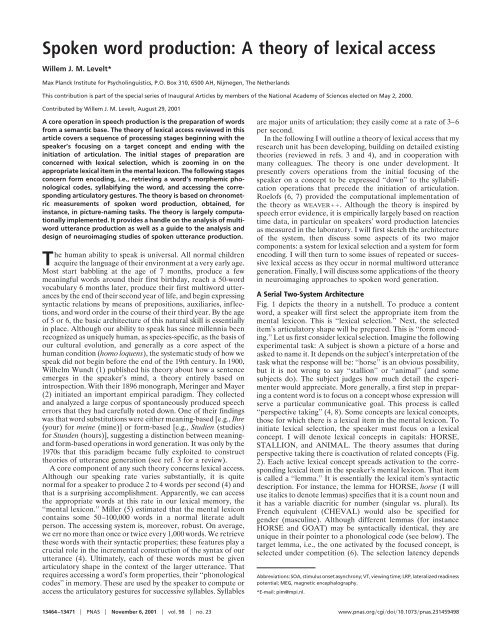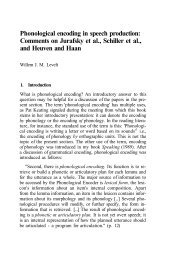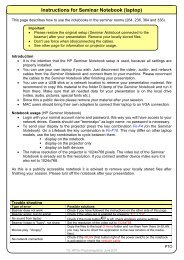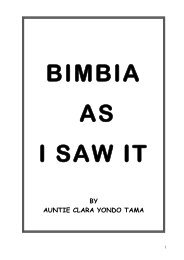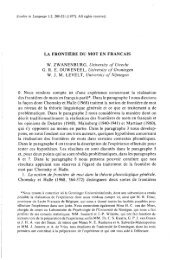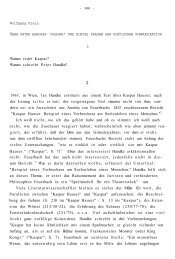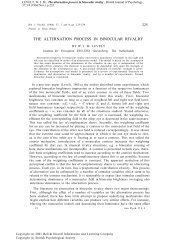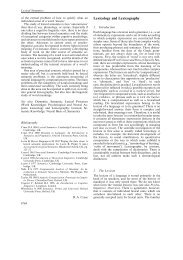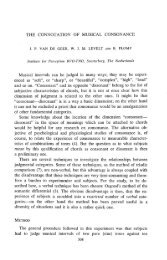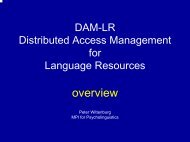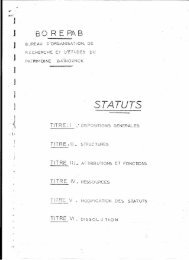Spoken word production: A theory of lexical access - Proceedings of ...
Spoken word production: A theory of lexical access - Proceedings of ...
Spoken word production: A theory of lexical access - Proceedings of ...
Create successful ePaper yourself
Turn your PDF publications into a flip-book with our unique Google optimized e-Paper software.
<strong>Spoken</strong> <strong>word</strong> <strong>production</strong>: A <strong>theory</strong> <strong>of</strong> <strong>lexical</strong> <strong>access</strong><br />
Willem J. M. Levelt*<br />
Max Planck Institute for Psycholinguistics, P.O. Box 310, 6500 AH, Nijmegen, The Netherlands<br />
This contribution is part <strong>of</strong> the special series <strong>of</strong> Inaugural Articles by members <strong>of</strong> the National Academy <strong>of</strong> Sciences elected on May 2, 2000.<br />
Contributed by Willem J. M. Levelt, August 29, 2001<br />
A core operation in speech <strong>production</strong> is the preparation <strong>of</strong> <strong>word</strong>s<br />
from a semantic base. The <strong>theory</strong> <strong>of</strong> <strong>lexical</strong> <strong>access</strong> reviewed in this<br />
article covers a sequence <strong>of</strong> processing stages beginning with the<br />
speaker’s focusing on a target concept and ending with the<br />
initiation <strong>of</strong> articulation. The initial stages <strong>of</strong> preparation are<br />
concerned with <strong>lexical</strong> selection, which is zooming in on the<br />
appropriate <strong>lexical</strong> item in the mental lexicon. The following stages<br />
concern form encoding, i.e., retrieving a <strong>word</strong>’s morphemic phonological<br />
codes, syllabifying the <strong>word</strong>, and <strong>access</strong>ing the corresponding<br />
articulatory gestures. The <strong>theory</strong> is based on chronometric<br />
measurements <strong>of</strong> spoken <strong>word</strong> <strong>production</strong>, obtained, for<br />
instance, in picture-naming tasks. The <strong>theory</strong> is largely computationally<br />
implemented. It provides a handle on the analysis <strong>of</strong> multi<strong>word</strong><br />
utterance <strong>production</strong> as well as a guide to the analysis and<br />
design <strong>of</strong> neuroimaging studies <strong>of</strong> spoken utterance <strong>production</strong>.<br />
The human ability to speak is universal. All normal children<br />
acquire the language <strong>of</strong> their environment at a very early age.<br />
Most start babbling at the age <strong>of</strong> 7 months, produce a few<br />
meaningful <strong>word</strong>s around their first birthday, reach a 50-<strong>word</strong><br />
vocabulary 6 months later, produce their first multi<strong>word</strong> utterances<br />
by the end <strong>of</strong> their second year <strong>of</strong> life, and begin expressing<br />
syntactic relations by means <strong>of</strong> prepositions, auxiliaries, inflections,<br />
and <strong>word</strong> order in the course <strong>of</strong> their third year. By the age<br />
<strong>of</strong> 5 or 6, the basic architecture <strong>of</strong> this natural skill is essentially<br />
in place. Although our ability to speak has since millennia been<br />
recognized as uniquely human, as species-specific, as the basis <strong>of</strong><br />
our cultural evolution, and generally as a core aspect <strong>of</strong> the<br />
human condition (homo loquens), the systematic study <strong>of</strong> how we<br />
speak did not begin before the end <strong>of</strong> the 19th century. In 1900,<br />
Wilhelm Wundt (1) published his <strong>theory</strong> about how a sentence<br />
emerges in the speaker’s mind, a <strong>theory</strong> entirely based on<br />
introspection. With their 1896 monograph, Meringer and Mayer<br />
(2) initiated an important empirical paradigm. They collected<br />
and analyzed a large corpus <strong>of</strong> spontaneously produced speech<br />
errors that they had carefully noted down. One <strong>of</strong> their findings<br />
was that <strong>word</strong> substitutions were either meaning-based [e.g., Ihre<br />
(your) for meine (mine)] or form-based [e.g., Studien (studies)<br />
for Stunden (hours)], suggesting a distinction between meaningand<br />
form-based operations in <strong>word</strong> generation. It was only by the<br />
1970s that this paradigm became fully exploited to construct<br />
theories <strong>of</strong> utterance generation (see ref. 3 for a review).<br />
A core component <strong>of</strong> any such <strong>theory</strong> concerns <strong>lexical</strong> <strong>access</strong>.<br />
Although our speaking rate varies substantially, it is quite<br />
normal for a speaker to produce 2 to 4 <strong>word</strong>s per second (4) and<br />
that is a surprising accomplishment. Apparently, we can <strong>access</strong><br />
the appropriate <strong>word</strong>s at this rate in our <strong>lexical</strong> memory, the<br />
‘‘mental lexicon.’’ Miller (5) estimated that the mental lexicon<br />
contains some 50–100,000 <strong>word</strong>s in a normal literate adult<br />
person. The <strong>access</strong>ing system is, moreover, robust. On average,<br />
we err no more than once or twice every 1,000 <strong>word</strong>s. We retrieve<br />
these <strong>word</strong>s with their syntactic properties; these features play a<br />
crucial role in the incremental construction <strong>of</strong> the syntax <strong>of</strong> our<br />
utterance (4). Ultimately, each <strong>of</strong> these <strong>word</strong>s must be given<br />
articulatory shape in the context <strong>of</strong> the larger utterance. That<br />
requires <strong>access</strong>ing a <strong>word</strong>’s form properties, their ‘‘phonological<br />
codes’’ in memory. These are used by the speaker to compute or<br />
<strong>access</strong> the articulatory gestures for successive syllables. Syllables<br />
are major units <strong>of</strong> articulation; they easily come at a rate <strong>of</strong> 3–6<br />
per second.<br />
In the following I will outline a <strong>theory</strong> <strong>of</strong> <strong>lexical</strong> <strong>access</strong> that my<br />
research unit has been developing, building on detailed existing<br />
theories (reviewed in refs. 3 and 4), and in cooperation with<br />
many colleagues. The <strong>theory</strong> is one under development. It<br />
presently covers operations from the initial focusing <strong>of</strong> the<br />
speaker on a concept to be expressed ‘‘down’’ to the syllabification<br />
operations that precede the initiation <strong>of</strong> articulation.<br />
Roel<strong>of</strong>s (6, 7) provided the computational implementation <strong>of</strong><br />
the <strong>theory</strong> as WEAVER. Although the <strong>theory</strong> is inspired by<br />
speech error evidence, it is empirically largely based on reaction<br />
time data, in particular on speakers’ <strong>word</strong> <strong>production</strong> latencies<br />
as measured in the laboratory. I will first sketch the architecture<br />
<strong>of</strong> the system, then discuss some aspects <strong>of</strong> its two major<br />
components: a system for <strong>lexical</strong> selection and a system for form<br />
encoding. I will then turn to some issues <strong>of</strong> repeated or successive<br />
<strong>lexical</strong> <strong>access</strong> as they occur in normal multi<strong>word</strong> utterance<br />
generation. Finally, I will discuss some applications <strong>of</strong> the <strong>theory</strong><br />
in neuroimaging approaches to spoken <strong>word</strong> generation.<br />
A Serial Two-System Architecture<br />
Fig. 1 depicts the <strong>theory</strong> in a nutshell. To produce a content<br />
<strong>word</strong>, a speaker will first select the appropriate item from the<br />
mental lexicon. This is ‘‘<strong>lexical</strong> selection.’’ Next, the selected<br />
item’s articulatory shape will be prepared. This is ‘‘form encoding.’’<br />
Let us first consider <strong>lexical</strong> selection. Imagine the following<br />
experimental task: A subject is shown a picture <strong>of</strong> a horse and<br />
asked to name it. It depends on the subject’s interpretation <strong>of</strong> the<br />
task what the response will be: ‘‘horse’’ is an obvious possibility,<br />
but it is not wrong to say ‘‘stallion’’ or ‘‘animal’’ (and some<br />
subjects do). The subject judges how much detail the experimenter<br />
would appreciate. More generally, a first step in preparing<br />
a content <strong>word</strong> is to focus on a concept whose expression will<br />
serve a particular communicative goal. This process is called<br />
‘‘perspective taking’’ (4, 8). Some concepts are <strong>lexical</strong> concepts,<br />
those for which there is a <strong>lexical</strong> item in the mental lexicon. To<br />
initiate <strong>lexical</strong> selection, the speaker must focus on a <strong>lexical</strong><br />
concept. I will denote <strong>lexical</strong> concepts in capitals: HORSE,<br />
STALLION, and ANIMAL. The <strong>theory</strong> assumes that during<br />
perspective taking there is coactivation <strong>of</strong> related concepts (Fig.<br />
2). Each active <strong>lexical</strong> concept spreads activation to the corresponding<br />
<strong>lexical</strong> item in the speaker’s mental lexicon. That item<br />
is called a ‘‘lemma.’’ It is essentially the <strong>lexical</strong> item’s syntactic<br />
description. For instance, the lemma for HORSE, horse (I will<br />
use italics to denote lemmas) specifies that it is a count noun and<br />
it has a variable diacritic for number (singular vs. plural). Its<br />
French equivalent (CHEVAL) would also be specified for<br />
gender (masculine). Although different lemmas (for instance<br />
HORSE and GOAT) may be syntactically identical, they are<br />
unique in their pointer to a phonological code (see below). The<br />
target lemma, i.e., the one activated by the focused concept, is<br />
selected under competition (6). The selection latency depends<br />
Abbreviations: SOA, stimulus onset asynchrony; VT, viewing time; LRP, lateralized readiness<br />
potential; MEG, magnetic encephalography.<br />
*E-mail: pim@mpi.nl.<br />
13464–13471 PNAS November 6, 2001 vol. 98 no. 23 www.pnas.orgcgidoi10.1073pnas.231459498
Fig. 2. Fragment <strong>of</strong> the WEAVER <strong>lexical</strong> selection network. (Upper stratum)<br />
Lexical concept nodes. (Lower stratum) Lemma and gender nodes.<br />
Fig. 1. Serial two-system architecture <strong>of</strong> the <strong>theory</strong>: two stages <strong>of</strong> <strong>lexical</strong><br />
selection followed by three stages <strong>of</strong> form encoding.<br />
on the amount <strong>of</strong> coactivation <strong>of</strong> other lemmas (such as stallion<br />
and animal). Lexical selection is complete as soon as the target<br />
lemma is selected.<br />
This selection triggers the form encoding system (Fig. 3).<br />
Activation spreads from just the selected lemma to the phonological<br />
codes it points to; no other codes get coactivated (for<br />
instance, the codes <strong>of</strong> the coactivated lemmas stallion and animal<br />
remain silent). Many lemmas, for instance horse when marked<br />
for plural, have a multimorphemic code. A phonological code is<br />
retrieved for each <strong>of</strong> the morphemes, e.g., horse and iz,<br />
respectively. Phonological codes are ‘‘spelled out’’ as ordered<br />
sets <strong>of</strong> phonological segments, for instanceh, ɔ, r,sand I,Z. †<br />
This forms the input to the operation <strong>of</strong> ‘‘prosodification,’’ which<br />
is largely syllabification. The ordered segments are incrementally<br />
strung together to form legal syllables. In the example, a first<br />
syllable () is created out <strong>of</strong> h, ɔ, and r:hɔr and then<br />
a second one out <strong>of</strong> s, I and z:SIZ . This completes the<br />
syllabification <strong>of</strong> the phonological <strong>word</strong> (): hɔr.SIZ . Syllabification<br />
is context dependent: hɔr is a syllable <strong>of</strong> ‘‘horses’’ but<br />
is not one <strong>of</strong> ‘‘horse,’’ whereas hɔrs is a syllable <strong>of</strong> ‘‘horse,’’ but<br />
not <strong>of</strong> ‘‘horses.’’ An item’s syllabification is not stored in the<br />
mental lexicon but created on the fly, dependent on the current<br />
context. As syllables are incrementally composed, they are input<br />
to a final encoding step, phonetic encoding (Fig. 3). A core<br />
assumption <strong>of</strong> the <strong>theory</strong> is the existence <strong>of</strong> a ‘‘mental syllabary.’’<br />
This is a repository <strong>of</strong> highly practiced syllabic gestures (10). As<br />
syllabification proceeds, the corresponding syllabic patterns are<br />
selected from the syllabary for execution. Phonetic encoding also<br />
involves the smooth concatenation <strong>of</strong> retrieved syllabic routines.<br />
The string <strong>of</strong> syllabic gestural routines that corresponds to the<br />
target phonological <strong>word</strong> is called its ‘‘articulatory score.’’ It is<br />
the output <strong>of</strong> form encoding and the final product <strong>of</strong> <strong>lexical</strong><br />
<strong>access</strong>. The execution <strong>of</strong> successive articulatory scores by the<br />
speaker’s laryngeal and supralaryngeal apparatus, articulation<br />
(as yet outside the <strong>theory</strong>, but see ref. 4), creates overt speech.<br />
It is important to notice that the two systems involved in <strong>lexical</strong><br />
<strong>access</strong> (Fig. 1) perform radically different functions. The function<br />
<strong>of</strong> <strong>lexical</strong> selection is to rapidly focus on a single <strong>lexical</strong> item,<br />
given the speaker’s intentional state. This selection is subject to<br />
competition. The function <strong>of</strong> form encoding is to generate an<br />
articulatory score for just the selected item in its context.<br />
Competition is hardly an issue here. Initially, the two systems<br />
mature independently in the child’s mind (11) and they involve<br />
† The plural morpheme code for English is factually more abstract. I refrain from discussing<br />
in detail its realization as IZ (see ref. 9).<br />
different cerebral networks (12). The link between the systems<br />
is vulnerable. We all get occasionally into so-called ‘‘tip <strong>of</strong> the<br />
tongue’’ states, where the phonological code <strong>of</strong> a selected target<br />
item is temporarily partly or wholly unavailable, whereas syntactic,<br />
i.e., lemma information, is largely preserved (13). The rift<br />
between the systems is even magnified in certain anomic patients<br />
whose utterance <strong>production</strong> is normal, except that they block<br />
time and again on <strong>access</strong>ing the phonological codes <strong>of</strong> their<br />
target <strong>word</strong>s (14). Finally, the serial two-system architecture<br />
predicts that <strong>lexical</strong> selection precedes form encoding. Supporting<br />
electrophysiological evidence will be discussed in the final<br />
section <strong>of</strong> this article.<br />
Aspects <strong>of</strong> Lexical Selection<br />
A Case <strong>of</strong> Perspective Taking. Much <strong>of</strong> the original work on<br />
perspective taking concerned the ways in which speakers conceptualize<br />
spatial states <strong>of</strong> affairs for their listeners (refs. 15 and<br />
16; see ref. 17 for a comprehensive treatment <strong>of</strong> spatial perspective<br />
systems). If one asks subjects to describe the spatial pattern<br />
in Fig. 4A, which is put flat on the table in front <strong>of</strong> them, one gets<br />
two types <strong>of</strong> responses, depending on the perspective taken (18).<br />
Subjects taking the ‘‘intrinsic’’ perspective begin their description<br />
with something like ‘‘from the yellow dot you go straight to<br />
a green dot.’’ The directional term is ‘‘straight.’’ On successive<br />
moves, this is followed by ‘‘straight,’’ ‘‘right,’’ ‘‘straight,’’ ‘‘right,’’<br />
Fig. 3. Fragment <strong>of</strong> the WEAVER form encoding network (Left) with corresponding<br />
form-processing stages (Right). (Upper stratum) Nodes representing<br />
morphemic phonological codes and their phonemic ‘‘spellouts.’’ (Lower stratum)<br />
Nodes representing syllabic articulatory scores.<br />
PSYCHOLOGY<br />
Levelt PNAS November 6, 2001 vol. 98 no. 23 13465
Fig. 4. (A) Experimental visual pattern to be described. Pattern is flat on the<br />
table in front <strong>of</strong> the subject. Description starts from the arrow. On the outside,<br />
directional terms used in “intrinsic” perspective. On the inside, terms used in<br />
”relative” perspective. (B) A typical subject’s drawing <strong>of</strong> the same pattern<br />
from listening to an intrinsic description.<br />
and ‘‘right.’’ The subject makes a mental ‘‘body tour,’’ relating<br />
each new direction to the direction <strong>of</strong> the previous move. The<br />
description is invariant over rotations <strong>of</strong> the pattern on the table;<br />
it is intrinsic to the pattern, given the path <strong>of</strong> the tour. However,<br />
the majority <strong>of</strong> subjects take the relative perspective. They<br />
interestingly begin their descriptions with a vertical dimension<br />
term ‘‘up’’ (‘‘from yellow you go up to green’’), followed by ‘‘up,’’<br />
‘‘right,’’ ‘‘right,’’ ‘‘down,’’ and ‘‘left.’’ The vertical dimension<br />
terms emerge from the subjects making a ‘‘gaze tour.’’ At each<br />
move they tell you where their gaze is going relative to their own<br />
oriented body position (16, 19). A relative description changes<br />
entirely when you rotate the pattern by 90, 180, or 270° on the<br />
table. Both descriptions are veridical, but they are almost entirely<br />
different. The final direction is even ‘‘right’’ in the intrinsic<br />
description and ‘‘left’’ in the relative description. Here the target<br />
concept RIGHT and the target concept LEFT denote the same<br />
state <strong>of</strong> affairs, given the perspectives in which they function. The<br />
formal properties <strong>of</strong> the two perspectives are drastically different.<br />
For instance, transitivity and converseness hold for the<br />
relative but not for the intrinsic system (18). Speakers typically<br />
do not tell their addressees what perspective they are using,<br />
which can lead to major confusion. When we asked subjects to<br />
listen to an intrinsic description <strong>of</strong> the pattern in Fig. 4A (without<br />
seeing it) and to draw it from the description, they typically drew<br />
the pattern in Fig. 4B. Here they forced a relative interpretation<br />
onto an intrinsic description (18).<br />
Lemma Selection. Given a target concept, such as LEFT or<br />
HORSE, the subject will proceed to select the corresponding<br />
lemma. Let us assume that, in a picture-naming experiment,<br />
HORSE is the subject’s target concept (Fig. 2). It spreads part<br />
<strong>of</strong> its activation to the lemma node horse, which is the one to be<br />
selected. HORSE also sends part <strong>of</strong> its activation to semantically<br />
related concept nodes, such as those for ANIMAL and GOAT.<br />
In turn, these spread part <strong>of</strong> their activation to their lemma<br />
nodes, animal and goat. Hence, the lemma horse is selected under<br />
competition (at least if ‘‘animal’’ and ‘‘goat’’ are permitted<br />
responses in the experiment). The equations in the computational<br />
model WEAVER that govern activation spreading and<br />
decay, as well as selection probabilities, are given in refs. 6 and<br />
10. The basic notion is that during any minimal time unit, the<br />
probability <strong>of</strong> selecting the target lemma equals the ratio <strong>of</strong> its<br />
activation to the sum activation <strong>of</strong> all lemmas. This follows<br />
Luce’s (20) choice rule and it predicts the expected selection<br />
latency. The prediction can be experimentally tested by manipulating<br />
lemma coactivation. The classical procedure is to present<br />
a printed distracter <strong>word</strong> in the picture to be named (6, 21) or<br />
to present an auditory, spoken distracter <strong>word</strong> (22) while the<br />
subject is naming the picture. Presenting the semantically related<br />
Fig. 5. Effects <strong>of</strong> a semantic distracter on picture-naming (A) and picture<br />
categorization latencies (B) for different SOAs <strong>of</strong> picture and visual<br />
distracter <strong>word</strong>s. The semantic effect is the naming latency when the<br />
distracter is semantically related to the picture name minus the latency<br />
when the distracter <strong>word</strong> is unrelated to the picture name. Black squares<br />
represent data from Glaser and Düngelh<strong>of</strong>f (21). Open squares represent<br />
WEAVER simulations (6).<br />
<strong>word</strong> ‘‘goat’’ as a distracter when HORSE is the target concept,<br />
the competing lemma goat is activated by the distracter (Fig. 2).<br />
In addition it receives activation through activation spreading<br />
from HORSE to GOAT to goat. If an unrelated distracter <strong>word</strong><br />
is presented, such as ‘‘s<strong>word</strong>,’’ that will activate the lemma s<strong>word</strong>,<br />
which will also compete with target lemma horse. However,<br />
s<strong>word</strong> does not receive extra activation through activation<br />
spreading from HORSE (as was the case for goat). Hence, the<br />
response ‘‘horse’’ will be slower when ‘‘goat’’ is the distracter<br />
than when ‘‘s<strong>word</strong>’’ is. This is called semantic interference.<br />
Another experimental manipulation is to vary the stimulus onset<br />
asynchrony (SOA) between distracter and picture; the distracter<br />
can be presented simultaneously with the picture, earlier or later.<br />
As Roel<strong>of</strong>s (6) has shown, the dynamics <strong>of</strong> activation spreading<br />
in WEAVER predict the amount <strong>of</strong> semantic interference for<br />
different SOAs. Fig. 5A presents the classical measurements by<br />
Glaser and Düngelh<strong>of</strong>f (21) with printed distracters along with<br />
the WEAVER simulation. Still another manipulation is to<br />
change the task from naming to categorization. The subject is<br />
instructed to take a different perspective, namely to say ‘‘animal’’<br />
when seeing a horse or ‘‘weapon’’ when seeing a s<strong>word</strong>. Here<br />
WEAVER predicts facilitation by semantically related distracters<br />
for negative SOAs, and that fits the data obtained by Glaser<br />
and Düngelh<strong>of</strong>f (see Fig. 5B). Meanwhile, the body <strong>of</strong> evidence<br />
in support <strong>of</strong> the account by WEAVER <strong>of</strong> <strong>lexical</strong> selection is<br />
substantial (see ref. 10 for a review). Moreover, model and data<br />
provide estimates <strong>of</strong> the detailed time course <strong>of</strong> <strong>lexical</strong> <strong>access</strong>.<br />
Lexical selection is not always ‘‘conceptually driven.’’ In<br />
preparing the sentence, ‘‘I thought that Peter would be here,’’<br />
selection <strong>of</strong> the lemma that is triggered by a syntactic operation,<br />
not by focusing on a <strong>lexical</strong> concept (4).<br />
After selection <strong>of</strong> the lemma, its syntactic properties are<br />
<strong>access</strong>ible for further processing. Grammatical encoding, the<br />
construction <strong>of</strong> phrases, clauses, and whole sentences, depends<br />
entirely on this information (4). A simple example case is the<br />
construction <strong>of</strong> an adjective-noun phrase, such as ‘‘big arrow.’’<br />
The syntax <strong>of</strong> lemmas big and arrow allow them to ‘‘unify’’ in that<br />
order—see ref. 23 for a computational model <strong>of</strong> unification. In<br />
many gender-marking languages, such as German or Dutch, the<br />
gender <strong>of</strong> the noun gets marked on the adjective during unification<br />
(German, grosser Pfeil; Dutch, grote pijl). The gender <strong>of</strong><br />
the adjective lemma is variable, the gender <strong>of</strong> a noun is fixed. To<br />
set the gender value <strong>of</strong> the adjective, the speaker must retrieve<br />
the gender <strong>of</strong> the noun. The faster this is done, the shorter the<br />
encoding latency <strong>of</strong> the adjective. It is experimentally possible to<br />
facilitate gender <strong>access</strong> (24–26), expressed doubts (27) notwithstanding.<br />
Recently, Vigliocco et al. (28) achieved this facilitation<br />
by means <strong>of</strong> the following paradigm. Dutch bilingual subjects<br />
produced phrases such as ‘‘grote pijl’’ (big arrow) or ‘‘kleine pijl’’<br />
(small arrow) in response to an English stimulus <strong>word</strong> on the<br />
13466 www.pnas.orgcgidoi10.1073pnas.231459498 Levelt
Fig. 6. Additive effects <strong>of</strong> semantic competition and gender facilitation in<br />
<strong>lexical</strong> selection. The target utterance, a Dutch adjective-noun phrase, is<br />
produced in response to an English probe <strong>word</strong>. The target nouns in an<br />
experimental block are either semantically homogeneous or heterogeneous.<br />
The syntactic gender <strong>of</strong> the target nouns in a block is either homogeneous (all<br />
gender 1 or all gender 2) or heterogeneous (both genders mixed). Data is from<br />
Vigliocco et al. (28).<br />
screen (ARROW or arrow, respectively). Dutch has two genders,<br />
which are marked on the adjective as a schwa or as a null suffix<br />
(‘‘grote’’xrɔ:t vs. ‘‘groot’’xrɔ:t); they are not marked on the<br />
noun. In one condition <strong>of</strong> the experiment, target <strong>word</strong>s <strong>of</strong> both<br />
genders were mixed 5050; the gender was heterogeneous. In the<br />
other two conditions, all <strong>word</strong>s had the same gender, either the<br />
one or the other; gender was homogeneous. The heterogeneous<br />
and homogeneous conditions involved the same <strong>word</strong>s. Response<br />
latencies were a reliable 16 ms faster in the homogeneous<br />
than in the heterogeneous condition. Fig. 2 shows how this could<br />
have occurred. In Dutch, ‘‘pijl’’ (arrow) and ‘‘geit’’ (goat) have<br />
the same gender (gender 1). Repeated activation <strong>of</strong> that gender<br />
node will speed up its retrieval; this is called ‘‘gender priming.’’<br />
But mixing gender 1 items, such as ‘‘pijl’’ (arrow), with gender<br />
2 items, such as ‘‘paard’’ (horse), annihilates the effect.<br />
We could also use the translation paradigm to induce semantic<br />
competition (28). In a semantically homogeneous condition, the<br />
subjects translated items from the same semantic category, for<br />
instance all weapons, all animals, all plants, etc. In a semantically<br />
heterogeneous condition, the set <strong>of</strong> items was semantically mixed<br />
(a weapon, an animal, a plant, etc.). Again, the same items were<br />
involved in the two conditions, and the translation response was<br />
an adjective-noun combination. Response latencies were significantly<br />
longer (by 33 ms) in the homogeneous than in the<br />
heterogeneous condition, and this is what the WEAVER model<br />
predicts. Fig. 2 shows that there is activation spreading among<br />
same-category <strong>lexical</strong> concepts, i.e., among the animals and<br />
among the weapons but not between different-category items.<br />
This difference leads to smaller Luce (20) ratios in the homogeneous<br />
than in the heterogeneous conditions, and hence to<br />
longer selection latencies.<br />
What would happen if we orthogonally varied semantic competition<br />
and gender priming in the same experiment The<br />
theoretical option I explored is this: The speaker performs two<br />
successive operations, lemma selection and gender <strong>access</strong> [the<br />
latter is run only if the task requires it (see refs. 24 and 29)].<br />
Semantic competition affects the first operation, gender priming<br />
the second one. This predicts additive effects if the two experimental<br />
manipulations are combined (30) and that is what I<br />
found (ref. 28; see Fig. 6). This interpretation <strong>of</strong> two successive<br />
operations was recently confirmed by Schriefers and Teruel (26).<br />
They showed, by means <strong>of</strong> picture <strong>word</strong> interference experiments,<br />
that the peak interference effect from an auditory<br />
semantic distracter occurs at earlier SOAs than the peak effect<br />
<strong>of</strong> a gender congruous distracter.<br />
It would be premature to generalize these findings on gender<br />
<strong>access</strong> to each and every syntactic lemma property, such as<br />
number, person, or tense. The <strong>theory</strong> (10) leaves this open. In<br />
particular, it does not make the claim, neither for gender nor for<br />
any other syntactic feature, that it is selected under competition;<br />
we propose no Luce (20) ratio rule for the selection <strong>of</strong> feature<br />
values. The ways speakers <strong>access</strong> the syntax <strong>of</strong> item is still the<br />
least explored aspect <strong>of</strong> <strong>lexical</strong> selection.<br />
Aspects <strong>of</strong> Form Encoding<br />
Accessing the Phonological Code. A first step in crossing the rift<br />
from <strong>lexical</strong> selection to form encoding is to <strong>access</strong> the phonological<br />
code(s) <strong>of</strong> the selected item (Figs. 1 and 3). W.J.M.L. et<br />
al. (31) formulated as a core assumption <strong>of</strong> the <strong>theory</strong> that only<br />
a selected lemma spreads its activation across the rift to its<br />
phonological code. This hypothesis was based on the results <strong>of</strong><br />
a picture-naming experiment, which showed that upon seeing a<br />
picture <strong>of</strong> an object to be named (for instance a horse), the<br />
subject activated the corresponding lemma as well as lemmas <strong>of</strong><br />
semantically related concepts (such as goat). The subject also<br />
activated the phonological code <strong>of</strong> the target <strong>word</strong> (horse),<br />
but never to any extent the code <strong>of</strong> an active semantic alternative<br />
(such as goat). This assumption has been repeatedly challenged,<br />
and ultimately one exception turned up (32, 33). If you<br />
name an object with two synonym names, for instance a couch<br />
which can also be called ‘‘s<strong>of</strong>a,’’ both phonological codes can get<br />
simultaneously activated. My theoretical concession has been<br />
that double lemma selection is a possibility in case <strong>of</strong> synonymy<br />
(10). This hypothesis is consonant with speech error data.<br />
Synonym blends, such as ‘‘clear’’ for ‘‘close’’ and ‘‘near’’, are not<br />
uncommon, whereas semantic alternatives (such as ‘‘horse’’ and<br />
‘‘goat’’) hardly ever blend. Thus far, no other exceptions have<br />
been found.<br />
A further important aspect <strong>of</strong> <strong>access</strong>ing the phonological code<br />
is that it is <strong>word</strong> frequency (WF)-dependent. Accessing the code<br />
is slower for low-frequency than for high-frequency <strong>word</strong>s (34).<br />
The frequency <strong>of</strong> usage <strong>of</strong> a <strong>word</strong> is highly correlated with the<br />
age at which it has been acquired by the child (AoA), and these<br />
parameters are hard to disentangle. Hence, WF dependency can<br />
in part or in full be AoA dependency (10).<br />
Accessing the phonological code can be manipulated in a<br />
picture-naming experiment by presenting an auditory distracter<br />
that is or is not phonologically related to the target name. For<br />
instance, if the picture is one <strong>of</strong> a book, the spoken distracter<br />
<strong>word</strong> can be ‘‘boor’’ (begin-related to ‘‘book’’), ‘‘look’’ (endrelated<br />
to ‘‘book’’,) or ‘‘fan’’ (unrelated). Related distracters<br />
produced shorter naming latencies than unrelated ones (22, 35).<br />
This phonological facilitation effect was further explored by<br />
Meyers and Schriefers (36) for both begin- and end-related<br />
distracters. Fig. 7 presents a subset <strong>of</strong> these data as well as<br />
Roel<strong>of</strong>s’ (7) WEAVER simulations there<strong>of</strong>. It is not essential<br />
that the distracter is a <strong>word</strong> itself. Related non<strong>word</strong>s also<br />
produce facilitation. For instance, naming a hammer is facilitated<br />
by presenting its last syllable (‘‘mer’’) as a distracter (7). It<br />
is further irrelevant whether the phonologically related distracter<br />
is itself a whole syllable <strong>of</strong> the target <strong>word</strong> (37, 38). This finding<br />
supports the notion that for the tested languages (Dutch, German,<br />
and English), syllable structure is not represented in the<br />
phonological code.<br />
Taken together, these data support the theoretical assumption,<br />
implemented in WEAVER, that the phonological code is<br />
retrieved as a whole. Priming any <strong>of</strong> its parts facilitates retrieval<br />
<strong>of</strong> the entire code. However, it is likely that retrieving the codes<br />
<strong>of</strong> multimorphemic <strong>word</strong>s is performed incrementally, code<br />
after code. Roel<strong>of</strong>s (39) showed this to be the case for com-<br />
PSYCHOLOGY<br />
Levelt PNAS November 6, 2001 vol. 98 no. 23 13467
Fig. 7. Effects <strong>of</strong> a phonological distracter on picture-naming latencies, for<br />
different SOAs between picture onset and onset <strong>of</strong> spoken distracter. All<br />
picture names and distracter <strong>word</strong>s were disyllabic. (A) Distracter and target<br />
<strong>word</strong>s share their first syllables. (B) Distracter and target <strong>word</strong>s share their last<br />
syllables. The phonological effect is the naming latency when the distracter is<br />
phonologically related to the target name minus the naming latency when the<br />
distracter is unrelated. Black squares represent data from Meyer and Schriefers<br />
(36). Open squares represent WEAVER simulations (7).<br />
pounds. In fact, the morphology <strong>of</strong> a target <strong>word</strong> is a crucial<br />
factor in phonological encoding, as will be elaborated below.<br />
Incremental Syllabification and Morphological Frames. Syllabification<br />
may run over morpheme boundaries (as in ‘‘horses’’<br />
hɔr.SIZ ) and even over <strong>lexical</strong> boundaries (as in ‘‘he owns<br />
it’’oυn.SIt ). In English and many other languages, the syllabification<br />
<strong>of</strong> a <strong>word</strong> is context-dependent. Syllabification boundaries<br />
are determined by various syntactic and morphological<br />
conditions (4). The central theoretical claim is that syllabification<br />
is computed incrementally over the spelled-out phonological<br />
codes. The substantial experimental evidence proceeds from<br />
a paradigm introduced by Meyer (40, 41), ‘‘implicit priming’’<br />
(Table 1). The subject learns a small set <strong>of</strong> semantically related<br />
probe-target pairs, for instance ‘‘single-loner,’’ ‘‘place-local,’’<br />
and ‘‘fruit-lotus’’ (Table 1, Set 1; the target <strong>word</strong>s are displayed<br />
only). Then the probe <strong>word</strong>s are repeatedly presented on the<br />
screen, in random order. Each time the subject responds by<br />
producing the corresponding target <strong>word</strong>. Speech onset latencies<br />
are measured. Next, a second set is learned (Table 1, Set 2; target<br />
<strong>word</strong>s ‘‘beacon,’’ ‘‘beadle,’’ and ‘‘beaker’’), and the response<br />
procedure is repeated for this set. Finally, the procedure is run<br />
on a third set (Table 1, Set 3). Each <strong>of</strong> these sets is homogeneous<br />
in that the target <strong>word</strong>s begin with the same syllable (‘‘lo,’’ ‘‘bea,’’<br />
and ‘‘ma,’’ respectively). The speaker implicitly knows the first<br />
syllable <strong>of</strong> the target <strong>word</strong>. To check whether this facilitates the<br />
encoding <strong>of</strong> the first syllable <strong>of</strong> the target <strong>word</strong>, the same <strong>word</strong>s<br />
are arranged into three different sets (sets 4, 5, and 6 in Table<br />
1). Target <strong>word</strong>s in these sets do not share their first syllables.<br />
Will onset latencies be slower here They are indeed, by some 30<br />
ms. The crucial test for incrementality <strong>of</strong> encoding is to use the<br />
same paradigm on sets <strong>of</strong> target <strong>word</strong>s that share a noninitial<br />
stretch. This is the case for sets 7–9 in Table 1; the target <strong>word</strong>s<br />
share their last syllables (‘‘to,’’ ‘‘ble,’’ and ‘‘va,’’ respectively), but<br />
Table 1. Implicit priming <strong>of</strong> first (sets 1–3) and second (sets<br />
7–9) syllable<br />
Set S1 S2 S3 S7 S8 S9<br />
S4 loner beacon major S10 salto feable lava<br />
S5 local beadle maker S11 veto stable nova<br />
S6 lotus beaker maple S12 photo rubble diva<br />
their initial syllables are different. If subjects can use their<br />
implicit knowledge <strong>of</strong> the second syllable to speed up encoding,<br />
they should be faster on sets 7–9 than on sets 10–12, which do<br />
not share the final syllable. But this is not what happens. There<br />
is not even a tendency for response latencies to be shorter for sets<br />
7–9. The general finding turned out to be that there is never any<br />
implicit priming for <strong>word</strong>s which share a noninitial stretch, not<br />
even for monosyllabic rhyme <strong>word</strong>s such as ‘‘dock,’’ ‘‘lock,’’ and<br />
‘‘rock.’’ Syllabification is strictly incremental; you can only<br />
prepare a <strong>word</strong> from its start. There is measurable implicit<br />
priming if a target set shares only its first segment {‘‘pen,’’ ‘‘pot,’’<br />
‘‘pal’’}, more if it shares a first syllable, and even more if it shares<br />
two syllables out <strong>of</strong> three, etc. But priming less than a segment<br />
is impossible. If the target set is {‘‘ben,’’ ‘‘pot,’’ ‘‘pal’’}, the initial<br />
segments vary only in one phonological feature, voicing. That is<br />
enough to entirely annihilate implicit priming. You can prepare<br />
the initial segment <strong>of</strong> a <strong>word</strong> but not a subset <strong>of</strong> its phonological<br />
features, as Roel<strong>of</strong>s (42) has shown.<br />
Let us return to the encoding <strong>of</strong> multimorphemic <strong>word</strong>s, such<br />
as ‘‘horses.’’ Previously, I referred to evidence that the phonological<br />
codes <strong>of</strong> the morphemes <strong>of</strong> a <strong>word</strong> are successively<br />
retrieved. In fact, the morphological structure <strong>of</strong> the target <strong>word</strong><br />
plays a crucial role in phonological encoding. Janssen et al. (43)<br />
demonstrated this idea for Dutch inflectional morphology.<br />
Again, using the implicit priming paradigm, they showed that<br />
priming by a shared initial syllable is stronger when the target<br />
<strong>word</strong>s share their inflectional affix structure than when they do<br />
not. The experiments support the notion proposed in ref. 4 that,<br />
right after lemma selection, a morphological target frame is<br />
constructed (for instance ‘‘stemaffixaffix’’) into which the<br />
incrementally retrieved morphophonological codes are inserted.<br />
The process <strong>of</strong> constructing that frame can be implicitly primed.<br />
One function <strong>of</strong> constructing such a frame is to delineate the<br />
domains <strong>of</strong> syllabification. For English, a stemaffix frame<br />
typically indicates a single domain <strong>of</strong> syllabification, i.e., the<br />
domain <strong>of</strong> a phonological <strong>word</strong>, as is the case for hɔr.SIZ . But<br />
the stemstem frame <strong>of</strong> compounds (such as ‘‘popart’’) induces<br />
two successive domains <strong>of</strong> syllabification. Each stem gets realized<br />
as a single phonological <strong>word</strong>; the speaker first syllabifies the<br />
first stem (pɔp ) and then the second one (a: r t ). This<br />
syllabification has as a consequence that the middle p <strong>of</strong><br />
‘‘popart’’ is not realized as the first segment <strong>of</strong> the second syllable<br />
(as was the case for s in ‘‘horses’’). That we know because that<br />
p does not get aspirated, as a syllable-initial p does.<br />
Languages differ substantially in morphology and syllabification.<br />
The crosslinguistic study <strong>of</strong> incremental phonological encoding<br />
is only beginning. Chen et al. (44) used implicit priming<br />
to study incremental syllabification in Mandarin Chinese. Each<br />
syllable has one <strong>of</strong> four tones in Chinese. Word initial-syllable<br />
priming turned out to be possible, independent <strong>of</strong> tone. But tone<br />
priming alone was ineffective. Still, shared tone does contribute.<br />
The strongest priming was obtained when the target <strong>word</strong>s in a<br />
set shared their first syllable and its tone. Hence, tone priming<br />
is conditional on shared phonemic or syllabic content. It should<br />
not be surprising if form encoding differs substantially between<br />
Chinese and languages such as English or Dutch. In Mandarin<br />
Chinese, syllabification is not context-dependent, and the number<br />
<strong>of</strong> different syllables is exceedingly small (some 400, not<br />
counting tones). That would make it efficient for speakers to<br />
store syllable boundaries in the form lexicon and dispense with<br />
computing these boundaries on the fly during syllabification.<br />
Phonetic Encoding. Like Mandarin Chinese, many languages have<br />
no more than a few hundred different syllables. Assume you talk,<br />
from your 2nd to your 21st birthday, on average 30 min a day. If<br />
you speak at an average rate <strong>of</strong> 4 syllables per second, you will<br />
have produced 5.10 7 syllable tokens at reaching adulthood. If<br />
your language counts 500 different syllables, each <strong>of</strong> them will,<br />
13468 www.pnas.orgcgidoi10.1073pnas.231459498 Levelt
on average, have been produced some 10 5 times. This is a<br />
classical case <strong>of</strong> ‘‘overlearning.’’ Articulatory syllables are among<br />
the most exercised motor patterns we produce. Such overlearned<br />
motor actions typically get stored in the premotor cortex (45). I<br />
have called this hypothetical repository the ‘‘mental syllabary’’<br />
(46, 47). But what if a language has many more different<br />
syllables English and Dutch, for instance, have far more than<br />
10,000. Statistics show that speakers <strong>of</strong> these languages do 80%<br />
<strong>of</strong> their talking with no more than 500 different high-frequency<br />
syllables (10). Hence, these are hardly less overlearned as<br />
articulatory motor actions, and thus likely members <strong>of</strong> a speaker’s<br />
syllabary. Although we rarely produce a syllable that we<br />
never produced before, the low-frequency tail <strong>of</strong> the distribution<br />
may contain syllables which never became stored as motor<br />
patterns. The articulation <strong>of</strong> such items should be prepared on<br />
the fly from the syllabified phonological <strong>word</strong> (). Here I will<br />
limit to our modeling <strong>of</strong> syllabary <strong>access</strong> (7, 10). It is exemplified<br />
in Fig. 3. As soon as a phonological code is retrieved (for instance<br />
the code hɔrs), its segments activate all syllabic gestures in the<br />
syllabary in which they partake. As an example, the spelled-out<br />
segment s spreads activation to the articulatory syllables [hɔrs],<br />
[SIZ], and many others. There will, at any one moment, be just<br />
one target syllable, given the state <strong>of</strong> incremental phonological<br />
syllabification. Selection <strong>of</strong> that syllabic gesture occurs under<br />
competition, following the same selection mechanism as we saw<br />
above for lemma selection. But different from what was the case<br />
for lemma selection, the chronometric experimental support for<br />
the mechanism <strong>of</strong> syllable selection is still fragmentary.<br />
Multiple Lexical Access<br />
Initiating Multi<strong>word</strong> Phrases. Given the serial two-system architecture<br />
<strong>of</strong> <strong>lexical</strong> <strong>access</strong>, <strong>lexical</strong> selection followed by form<br />
encoding, one can now ask how <strong>access</strong> is organized in simple<br />
multiple-<strong>word</strong> utterances. Above we saw that it is possible to<br />
prime the gender <strong>of</strong> the noun in the <strong>production</strong> <strong>of</strong> a simple Dutch<br />
phrases such as ‘‘grote pijl’’—‘‘big arrow’’ (26, 28). Here, the<br />
gender <strong>of</strong> the noun must be marked on the adjective. The<br />
speaker cannot complete the form encoding <strong>of</strong> the adjective<br />
without having <strong>access</strong>ed the lemma <strong>of</strong> the noun, in particular its<br />
gender feature. Hence, in this case, form encoding <strong>of</strong> item 1<br />
depends on lemma <strong>access</strong> to item 2, and that has a measurable<br />
effect on the initiation <strong>of</strong> articulation. But even without such<br />
dependency, as is the case in English, the utterance is not<br />
initiated before the head noun has been selected. For instance,<br />
Costa and Caramazza (48) had subjects produce phrases such as<br />
‘‘the red car’’ in response to a picture. Simultaneously presented<br />
(visual) semantic distracter <strong>word</strong>s (such as ‘‘truck’’) delayed<br />
response initiation as compared with unrelated distracters.<br />
Meyer (49) had obtained the same result for more complicated<br />
locative utterances, such as the Dutch equivalent <strong>of</strong> ‘‘the baby is<br />
next to the dog’’ (in response to a two-object picture as in Fig.<br />
8). When subjects were given an auditory semantic distracter<br />
related to ‘‘dog’’ (for instance ‘‘cow’’), their response was slower<br />
than when the distracter was unrelated (for instance ‘‘pipe’’).<br />
However, this effect is not always obtained in utterances with<br />
multiple noun phrases. Here the planning window for <strong>lexical</strong><br />
selection is variable and strategic (50).<br />
What about the planning window <strong>of</strong> form encoding If item 2<br />
is selected before utterance initiation, is it also form encoded<br />
Meyer (49) showed that not to be the case for her locative<br />
sentences. In the example, a phonological distracter such as<br />
‘‘doll’’ related to item 2 (‘‘dog’’) did not facilitate speech onset<br />
for the utterance as a whole. Initially, the same was found for<br />
adjective-noun phrases such as ‘‘(the) red car’’: phonologically<br />
priming the noun did not facilitate onset latency (24, 51). More<br />
recently, however, Costa and Caramazza (48) did obtain such an<br />
effect, which confirms earlier findings by Wheeldon and Lahiri<br />
(52), using a different paradigm.<br />
Fig. 8. Visual scan during a scene description. As soon as the two-object<br />
picture appears, the subject makes a saccade from the fixation point to the left<br />
object. After some scanning <strong>of</strong> that object, the gaze shifts to the right one. VT<br />
is the total duration <strong>of</strong> fixating on an object. The utterance produced here is<br />
‘‘baby and dog.’’<br />
Coordinating Lexical Selection and Form Encoding During Utterance<br />
Generation. Utterance onset measurements cannot reveal the<br />
coordination <strong>of</strong> <strong>lexical</strong> selection and form encoding after speech<br />
onset. Meyer et al. (53) introduced an eye-scanning paradigm to<br />
study utterance encoding in scene-description tasks. Fig. 8<br />
exemplifies a typical experimental trial. The subject looks at a<br />
fixation point until a picture appears. The instruction is to<br />
describe the scene with an utterance such as ‘‘baby and dog.’’<br />
Meanwhile, the subject’s eye movements are being monitored by<br />
an eye-tracking system. Fig. 8 displays an actual eye scan<br />
obtained during such a trial. The experimental output consists <strong>of</strong><br />
the scanning pattern and the speech recording, both time-locked<br />
to picture onset. One important variable is ‘‘viewing time’’ (VT).<br />
VT is the duration <strong>of</strong> looking at an object (for instance the baby<br />
in Fig. 8). It begins with the first fixation on the object and ends<br />
with the saccade out <strong>of</strong> the object (toward the dog). The<br />
characteristic scanning pattern is that subjects view the objects,<br />
whether two or more, in the order <strong>of</strong> mention. That reflects their<br />
pattern <strong>of</strong> attending to the objects. The initial hypothesis by<br />
Meyer et al. was that subjects would visually attend to an object<br />
just long enough to select the appropriate <strong>lexical</strong> item. Form<br />
encoding could then follow while visual attention turns to the<br />
second object. But the experiments turned out otherwise. VT for<br />
the left object covaried with the difficulty <strong>of</strong> form encoding.<br />
Remember that the speed <strong>of</strong> <strong>access</strong>ing phonological code <strong>of</strong> a<br />
<strong>word</strong> is <strong>word</strong> frequency-dependent (34). When Meyer et al.<br />
compared scenes where the left object had a high-frequency<br />
name as opposed to a low-frequency name (controlling for visual<br />
recognizability), they obtained a corresponding difference in<br />
VTs <strong>of</strong> 28 ms. Similarly, priming the phonological encoding <strong>of</strong><br />
the left object’s name (‘‘baby’’ in Fig. 8), by presenting the subject<br />
with a phonological distracter <strong>word</strong> (for instance ‘‘lobby’’),<br />
shortened VTs on average by a reliable 36 ms (54). VTs were also<br />
longer for objects named with a full noun than for objects named<br />
with a pronoun (such as ‘‘it’’; ref. 55). Taken together, these data<br />
suggest that the speaker keeps visually attending to the target<br />
object until phonological encoding, including syllabification, is<br />
complete (50). The functional significance <strong>of</strong> this strategy is a<br />
matter <strong>of</strong> dispute. Speakers may construct successive ‘‘attentional<br />
islands’’ to minimize interference between subsequent<br />
same-kind operations (<strong>lexical</strong> selection, phonological encoding).<br />
Such interference can cause speech errors. On the other hand,<br />
visual attention should shift early enough to keep the utterance<br />
fluent. The balance is a subtle one, and speakers can fail both<br />
ways.<br />
PSYCHOLOGY<br />
Levelt PNAS November 6, 2001 vol. 98 no. 23 13469
Fig. 9. A metaanalysis <strong>of</strong> 58 neuroimaging studies <strong>of</strong> <strong>word</strong> <strong>production</strong>.<br />
Colors denote regions whose activations correspond to theoretical processing<br />
stages as indicated. Contributions <strong>of</strong> insula, subcortical regions, and cerebellum<br />
are not shown. [Reproduced with permission from ref. 64 (Copyright<br />
2000, MIT Press, Cambridge, MA).]<br />
Some Neurological Perspectives<br />
The <strong>theory</strong> has been a guide to chronometric studies <strong>of</strong> cerebral<br />
activation in <strong>word</strong> <strong>production</strong>. It has also contributed to metaanalyses<br />
<strong>of</strong> localizational positron-emission tomography (PET)<br />
and functional MRI (fMRI) studies <strong>of</strong> <strong>word</strong> <strong>production</strong>.<br />
Time Course Studies. The <strong>theory</strong> is largely based on chronometric<br />
studies <strong>of</strong> <strong>lexical</strong> <strong>access</strong>. Combined with Roel<strong>of</strong>s’ computational<br />
modeling, the <strong>theory</strong> provided initial estimates <strong>of</strong> the time<br />
course <strong>of</strong> the various operations involved in <strong>lexical</strong> selection and<br />
form encoding (56). However, measurements <strong>of</strong> speech onset<br />
latency have limited potential in this respect. The reaction time<br />
is the cumulative effect <strong>of</strong> no less than five successive operations<br />
(Fig. 1). How to distinguish these operations in the temporal<br />
domain In some cases, SOA studies provide the relevant data.<br />
For instance, the peak effect <strong>of</strong> a semantic distracter or probe<br />
during picture naming always precedes the peak effect <strong>of</strong> a<br />
phonological one (31, 35). The difference provides an estimate<br />
<strong>of</strong> the time lapse between the successive operations <strong>of</strong> lemma<br />
selection and phonological code retrieval. For most pairs <strong>of</strong><br />
stages, however, such distracter studies are impossible.<br />
Here the measurement <strong>of</strong> evoked electrical and magnetic<br />
brain responses has come to the rescue. Van Turennout et al. (57)<br />
were the first to measure lateralized readiness potentials (LRPs)<br />
to distinguish between stages <strong>of</strong> <strong>lexical</strong> <strong>access</strong>. This measure is<br />
based on the electrophysiological brain potential that precedes<br />
any voluntary hand movement. The LRP is measured timelocked<br />
to the stimulus, for instance a picture presented to the<br />
subject. The subject provides a push-button response to an<br />
aspect <strong>of</strong> the picture, indicating for instance whether it is animate<br />
or inanimate, whether its name begins with borvor, in<br />
experiments on Dutch and German <strong>word</strong> <strong>production</strong>, whether<br />
the name has syntactic gender 1 or gender 2. Crucial for the<br />
experiments is that, under specific conditions, an LRP can be<br />
measured not only preceding an overt response, i.e., in the ‘‘go’’<br />
condition, but also in a ‘‘no-go’’ condition. For instance, when<br />
the subject is instructed to respond to the gender <strong>of</strong> the <strong>word</strong>, but<br />
only in case the target <strong>word</strong> begins with b, not in case it begins<br />
withz, the latter condition still induces an LRP, which reveals<br />
the subject’s preparation to give a gender response even in the<br />
‘‘no-go’’ condition. The phonological code comes too late to<br />
prevent preparing a gender response. No such no-go LRP<br />
appears if the subject is instructed to respond to the initial letter<br />
<strong>of</strong> the <strong>word</strong>, borz, but only in case the target <strong>word</strong> is <strong>of</strong><br />
gender 1. According to the <strong>theory</strong>, the subject retrieves the<br />
gender <strong>of</strong> the <strong>word</strong> before its phonological code. The gender<br />
information is timely enough to prevent preparation <strong>of</strong> a phonological<br />
response. By using the LRP method, rather precise<br />
estimates can be made <strong>of</strong> the time course <strong>of</strong> semantic, syntactic,<br />
and phonological activations. For instance, van Turennout et al.<br />
(58) measured a 40-ms delay between <strong>access</strong>ing the gender <strong>of</strong> a<br />
<strong>word</strong> and <strong>access</strong>ing its first phoneme. Schmitt et al. (59, 60)<br />
added a further electrophysiological response to the time course<br />
measurement <strong>of</strong> <strong>word</strong> <strong>production</strong>, the N200 potential. It measures<br />
response inhibition, which is a central aspect <strong>of</strong> the<br />
just-mentioned experimental paradigm. One <strong>of</strong> their important<br />
findings was that conceptual focusing precedes gender <strong>access</strong> by<br />
some 80 ms.<br />
Magnetic encephalography (MEG) has also been used to<br />
answer time course questions raised by the <strong>theory</strong>. In addition,<br />
whole-head MEG provides useful information about brain regions<br />
that are involved in successive stages <strong>of</strong> <strong>word</strong> <strong>production</strong>.<br />
W.J.M.L. et al. (56) used a picture-naming task to explore the<br />
chronometry derived from the <strong>theory</strong> in relation to the spatiotemporal<br />
distribution <strong>of</strong> brain activation from picture onset to<br />
onset <strong>of</strong> articulation. A core finding was that during the (estimated)<br />
time window <strong>of</strong> phonological encoding (275–400 ms<br />
after picture onset) peak activity was observed in a cluster <strong>of</strong><br />
dipole sources in classical Wernicke’s area (a left posterior<br />
temporal region), which is known to be a repository <strong>of</strong> <strong>word</strong><br />
forms, i.e., phonological codes. In a recent MEG study, Maess et<br />
al. (61) specifically tested the operation <strong>of</strong> lemma selection.<br />
From earlier picture-naming studies, selection was estimated to<br />
take place around 200 ms after picture onset. They used a picture<br />
version <strong>of</strong> the translation paradigm discussed previously (29). In<br />
one condition, subjects named pictures in blocks from a single<br />
semantic category, for instance just vehicles or just animals (the<br />
‘‘homogeneous’’ condition). In another condition, they named<br />
the same pictures in blocks consisting <strong>of</strong> different semantic<br />
categories, for instance containing a vehicle, an animal, etc. (the<br />
‘‘heterogeneous’’ condition). Subjects were slower in the homogeneous<br />
than in the heterogeneous blocks and, as discussed<br />
previously, this is the result <strong>of</strong> competition in lemma selection.<br />
A principal components analysis (PCA) over the time courses <strong>of</strong><br />
dipole activation (251 dipoles were ‘‘projected’’ 15 mm below the<br />
surface <strong>of</strong> the dura) produced one factor that significantly<br />
distinguished between the activation patterns obtained in the<br />
homogeneous and heterogeneous conditions. The difference<br />
appeared in a time window <strong>of</strong> 150–225 ms post picture onset.<br />
This finding confirms and further specifies the earlier chronometric<br />
estimates for this stage <strong>of</strong> processing ‡ . The relevant PCA<br />
factor reflects a region in the left lateral temporal lobe. This is<br />
in excellent agreement with metaanalysis findings (see below).<br />
Metaanalyses. Positron-emission tomography (PET) and functional<br />
MRI (fMRI) studies <strong>of</strong> spoken <strong>word</strong> <strong>production</strong> have used<br />
a variety <strong>of</strong> experimental tasks, such as picture-naming and<br />
<strong>word</strong>-reading, and a wide range <strong>of</strong> brain regions have been<br />
reported to be involved in the execution <strong>of</strong> these tasks. Can this<br />
cerebral network be transparently related to the processing<br />
components <strong>of</strong> the present <strong>theory</strong> Indefrey and W.J.M.L. (62,<br />
63) performed metaanalyses <strong>of</strong> the published neuroimaging<br />
experiments on <strong>word</strong> <strong>production</strong>, using the processing <strong>theory</strong> to<br />
make the relevant contrasts. This approach required a detailed<br />
analysis <strong>of</strong> the experimental tasks used. For instance, in a<br />
picture-naming task there is a task-specific ‘‘lead in’’ process:<br />
visual object recognition. After object recognition, all ‘‘core’’<br />
processes <strong>of</strong> <strong>lexical</strong> preparation (Fig. 1) follow suit, from perspective<br />
taking and lemma selection all the way to phonetic<br />
‡ The conditions also contrasted at the much later time window <strong>of</strong> 450–475 ms, shortly<br />
before speech onset. This result was adduced to semantic self-monitoring, not discussed<br />
in the present article, but see Fig. 9.<br />
13470 www.pnas.orgcgidoi10.1073pnas.231459498 Levelt
encoding. Another much-used task, verb generation (the subject<br />
hears a noun such as ‘‘apple’’ and produces a verb denoting a use<br />
for it, e.g., ‘‘eat’’), has a different lead-in: auditory <strong>word</strong> recognition<br />
and imagining a use <strong>of</strong> the object. From there again all<br />
core processes <strong>of</strong> <strong>word</strong> <strong>production</strong> are run like in picturenaming.<br />
Compare these to a task such as <strong>word</strong>-reading. Here the<br />
task-specific lead-in process is <strong>word</strong> recognition, mapping the<br />
visual <strong>word</strong> onto the corresponding phonological code. After<br />
retrieval <strong>of</strong> that code, the remaining core processes, syllabification<br />
and phonetic encoding are run before articulation can be<br />
initiated. Note that there is no conceptually driven lemma<br />
selection here. By contrasting all imaging data from tasks that do<br />
involve lemma selection to tasks that do not (and by using a<br />
binomial statistical ‘‘filter’’), one region was found that systematically<br />
distinguished between them: the mid-section <strong>of</strong> the left<br />
middle temporal gyrus. This finding is in fine agreement with the<br />
above-mentioned MEG study <strong>of</strong> lemma selection (61), which<br />
showed the left lateral temporal lobe to be involved with that<br />
operation.<br />
The task analyses allowed us to construct other contrasts as<br />
well. For instance, we compared brain activations for tasks<br />
involving phonological code retrieval (such as picture-naming<br />
and <strong>word</strong>-reading) to tasks that do not (reading a non<strong>word</strong> such<br />
as ‘‘flimtis’’). This contrast showed the specific involvement <strong>of</strong><br />
Wernicke’s area in phonological code retrieval in agreement<br />
with the above-mentioned MEG findings (56). Fig. 9 summarizes<br />
the main findings <strong>of</strong> the original metaanalysis (62, 63) over 58<br />
published data sets. A recent extension to 82 data sets confirms<br />
and refines these findings.<br />
Prospects. These post hoc analyses display a satisfying transparency<br />
between the extensive network involved in the <strong>production</strong><br />
<strong>of</strong> spoken <strong>word</strong>s and the <strong>theory</strong> <strong>of</strong> <strong>lexical</strong> <strong>access</strong> reviewed in this<br />
article. Clearly, the <strong>theory</strong> has the potential to guide the<br />
construction <strong>of</strong> neuroimaging studies <strong>of</strong> <strong>word</strong> <strong>production</strong> which<br />
are substantially more specific than what has hitherto been done.<br />
In particular, it invites a directed approach to issues such as<br />
lemma selection, <strong>access</strong>ing syntactic features, morphological<br />
encoding, and syllabification, which have rarely been the subject<br />
<strong>of</strong> positron-emission tomography (PET) or functional MRI<br />
(fMRI) research.<br />
I thank Antje Meyer and Ardi Roel<strong>of</strong>s, whose contributions to the <strong>theory</strong><br />
are invaluable, for helpful comments.<br />
1. Wundt, W. (1900) Die Sprache (Engelmann, Leipzig, Germany).<br />
2. Meringer, R. & Mayer, K. (1896) Versprechen und Verlesen (Goschen, Stuttgart).<br />
3. Levelt, W. J. M. (1999) Trends Cogn. Sci. 3, 223–232.<br />
4. Levelt, W. J. M. (1989) Speaking: From Intention to Articulation (MIT Press,<br />
Cambridge, MA).<br />
5. Miller, G. A. (1991) The Science <strong>of</strong> Words (Scientific American, New York).<br />
6. Roel<strong>of</strong>s, A. (1992) Cognition 42, 107–142.<br />
7. Roel<strong>of</strong>s, A. (1997) Cognition 64, 249–284.<br />
8. Clark, E. (1997) Cognition 64, 1–37.<br />
9. Halle, M. (1978) in Linguistic Theory and Psychological Reality, eds. Halle, M.,<br />
Bresnan, J. & Miller, G. A. (MIT Press, Cambridge, MA).<br />
10. Levelt, W. J. M., Roel<strong>of</strong>s, A. & Meyer, A. S. (1999) Behav. Brain Sci. 22, 1–38.<br />
11. Levelt, W. J. M. (1998) J. Psycholinguist. Res. 27, 167–180.<br />
12. Levelt, W. J. M. (2001) in Language, Brain, and Cognitive Development: Essays<br />
in Honor <strong>of</strong> Jacques Mehler, ed. Dupoux, E. (MIT Press, Cambridge, MA).<br />
13. Vigliocco, G., Antonioni, T. & Garrett, M. F. (1997) Psychol. Sci. 8, 314–317.<br />
14. Badecker, W., Miozzo, M. & Zanuttini, R. (1995) Cognition 57, 193–216.<br />
15. Miller, G. A. & Johnson-Laird, P. N. (1976) Language and Perception (MIT<br />
Press, Cambridge, MA).<br />
16. Levelt, W. J. M. (1982) in Speech, Place, and Action: Studies in Deixis and<br />
Related Topics, eds. Jarvella, R. J. & Klein, W. (Wiley, New York).<br />
17. Levinson, S. C. Space in Language and Cognition: Explorations in Cognitive<br />
Diversity (Cambridge Univ. Press, Cambridge, U.K.), in press.<br />
18. Levelt, W. J. M. (1996) in Language and Space, eds. Bloom, P., Peterson, M. A.<br />
& Nadel, L. (MIT Press, Cambridge, MA).<br />
19. Shepard, R. & Hurwitz, S. (1982) Cognition 18, 161–193.<br />
20. Luce, R. D. (1959) Individual Choice Behavior (Wiley, London).<br />
21. Glaser, W. R. & Düngelh<strong>of</strong>f, F.-J. (1984) J. Exp. Psychol. Hum. Percept.<br />
Perform. 10, 640–654.<br />
22. Schriefers, H., Meyer, A. S. & Levelt, W. J. M. (1990) J. Mem. Lang. 29, 86–102.<br />
23. Kempen, G. (2001) in The Syntax–Semantics Interface. Linguistic Structures and<br />
Processes, eds. Härtl, H., Olsen, S. & Tappe, H. (De Gruyter, Berlin).<br />
24. Schriefers, H. (1993) J. Exp. Psychol. Learn. Mem. Cognit. 19, 841–850.<br />
25. La Hey, W., Mak, P., Sander, J. & Willeboordse, E. (1998) Psychol. Res. 61,<br />
209–219.<br />
26. Schriefers, H. & Teruel, E. (2000) J. Exp. Psychol. Learn. Mem. Cognit. 26,<br />
1368–1377.<br />
27. Costa, A., Sebastián-Gallés, N., Miozzo, M. & Caramazza, A. (1999) Lang.<br />
Cogn. Processes 14, 381–391.<br />
28. Vigliocco, G., Lauer, M., Damian, M. F. & Levelt, W. J. M. J. Exp. Psychol.<br />
Learn. Mem. Cognit., in press.<br />
29. Damian, M. F., Vigliocco, G. & Levelt, W. J. M. (2001) Cognition 81, B77–B86.<br />
30. Sternberg, S. (1969) Acta Psychologica 30, 276–315.<br />
31. Levelt, W. J. M., Schriefers, H., Vorberg, D., Meyer, A. S., Pechmann, Th. &<br />
Havinga, J. (1991) J. Psychol. Rev. 98, 615–618.<br />
32. Peterson, R. R. & Savoy, P. (1998) J. Exp. Psychol. Learn. Mem. Cognit. 24,<br />
539–557.<br />
33. Jescheniak, J. D. & Schriefers, H. (1998) J. Exp. Psychol. Learn. Mem. Cognit.<br />
24, 1256–1274.<br />
34. Jescheniak, J. D. & Levelt, W. J. M. (1994) J. Exp. Psychol. Learn. Mem. Cognit.<br />
20, 824–843.<br />
35. Roel<strong>of</strong>s, A. Quart. J. Exp. Psychol., in press.<br />
36. Meyers, A. S. & Schriefers, H. (1991) J. Exp. Psychol. Learn. Mem. Cognit. 17,<br />
1146–1160.<br />
37. Baumann, M. (1995) The Production <strong>of</strong> Syllables in Connected Speech (MPI,<br />
Nijmegen, The Netherlands).<br />
38. Schiller, N. O. (2000) J. Exp. Psychol. Learn. Mem. Cognit. 26, 512–528.<br />
39. Roel<strong>of</strong>s, A. (1996) J. Mem. Lang. 35, 854–876.<br />
40. Meyer, A. S. (1990) J. Mem. Lang. 29, 524–545.<br />
41. Meyer, A. S. (1991) J. Mem. Lang. 30, 69–89.<br />
42. Roel<strong>of</strong>s, A. (1999) Lang. Cogn. Processes 14, 173–200.<br />
43. Janssen, D. P., Roel<strong>of</strong>s, A. & Levelt, W. J. M. Lang. Cogn. Processes, in press.<br />
44. Chen, J.-Y., Chen, T.-M. & Dell, G. J. Mem. Lang., in press.<br />
45. Rizzolatti, G. & Gentilucci, M. (1988) in Neurobiology <strong>of</strong> Motor Cortex, eds.<br />
Rakic, P. & Singer, W. (Wiley, New York).<br />
46. Levelt, W. J. M. (1992) Cognition 42, 1–22.<br />
47. Levelt, W. J. M. & Wheeldon, L. (1994) Cognition 50, 239–269.<br />
48. Costa, A. & Caramazza, A. J. Mem. Lang., in press.<br />
49. Meyer, A. S. (1996) J. Mem. Lang. 35, 477–496.<br />
50. Levelt, W. J. M. & Meyer, A. S. (2000) Eur. J. Cogn. Psychol. 12, 433–452.<br />
51. Schriefers, H. & Teruel, E. (1999) Eur. J. Cogn. Psychol. 11, 17–50.<br />
52. Wheeldon, L. & Lahiri, A. (1997) J. Mem. Lang. 37, 356–381.<br />
53. Meyer, A. S., Sleiderink, A. M. & Levelt, W. J. M. (1998) Cognition 66,<br />
B25–B33.<br />
54. Meyer, A. S. & Van der Meulen, F. (2000) Psychon. Bull. Rev. 7, 314–319.<br />
55. Van der Meulen, F., Meyer, A. S. & Levelt, W. J. M. (2001) Mem. Cogn. 29,<br />
512–521.<br />
56. Levelt, W. J. M., Praamstra, P., Meyer, A. S., Helenius, P. & Salmelin, R. (1998)<br />
J. Cogn. Neurosci. 88, 553–567.<br />
57. Van Turennout, M., Hagoort, P. & Brown, C. M. (1997) J. Exp. Psychol. Learn.<br />
Mem. Cognit. 23, 787–806.<br />
58. Van Turennout, M., Hagoort, P. & Brown, C. M. (1998) Science 280, 572–574.<br />
59. Schmitt, B. M., Münte, T. F. & Kutas, M. (2000) J. Mem. Lang. 37, 473–484.<br />
60. Schmitt, B. M., Schiltz, K., Zaake, W., Kutas, M. & Münte, T. F. (2001) J. Cogn.<br />
Neurosci. 13, 510–522.<br />
61. Maess, B., Friederici, A. D., Damian, M., Meyer, A. S. & Levelt, W. J. M. (2001)<br />
J. Cogn. Neurosci., in press.<br />
62. Indefrey, P. & Levelt, W. J. M. (2000) in The New Cognitive Sciences, ed.<br />
Gazzaniga, M. (MIT Press, Cambridge, MA).<br />
63. Levelt, W. J. M. & Indefrey, P. (2000) in Image, Language, Brain, eds. Marantz,<br />
A., Miyashita, Y. & O’Neil, W. (MIT Press, Cambridge, MA).<br />
PSYCHOLOGY<br />
Levelt PNAS November 6, 2001 vol. 98 no. 23 13471


